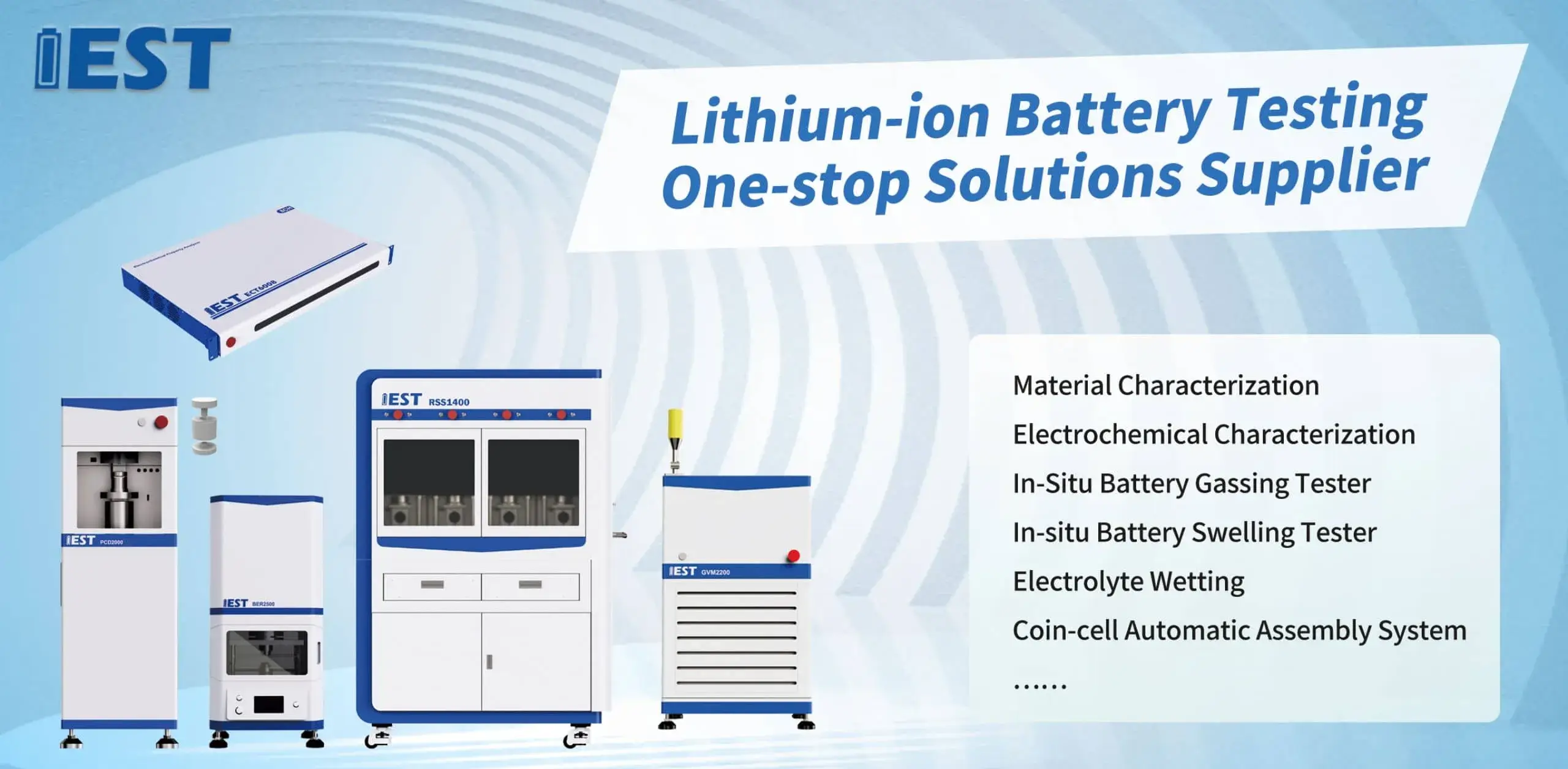EMC protected circuits programmable battery cycler solution

EIS testing reveals internal electrochemical properties in Li-ion cells, when thermal conditions change. By analyzing the impedance response of the battery across a spectrum of frequencies, valuable insights can be uncovered regarding the internal resistance, charge transfer kinetics, and overall state of health of the lithium-ion battery system. For example, EIS testing can help to quantify the impact caused by temperature fluctuations on key variables such as electrode polarization resistance, ionic conductivity, and double layer capacitance.
- In addition, EIS data can be used to uncover potential failure mechanisms resulting to thermal stress, enabling the development of strategies for optimizing battery construction and improving their overall useful life.
- The information is crucial for ensuring the safe and stable operation throughout lithium-ion batteries in a wide range including applications, such as EVs, consumer electronics and grid storage.
Rapid Degradation Assessment of Lithium Batteries: A Comprehensive Analysis
Lithium battery technology supports numerous gadgets, demanding rigorous testing to ensure their reliability and longevity. ADT is a principal testing strategy for simulating the responses of prolonged use and diverse ambient conditions on battery performance. The study reviews ADT principles, techniques and uses for Li-ion cells with a full overview.
ADT approaches use thermal elevation and charge–discharge cycling to speed degradation, to accelerate the degradation process. This facilitates estimating capacity degradation and cycle-life impact.
Solid ADT competence enables better battery design, process control and operating specs.
EIS Diagnostics for Lithium Batteries
EIS measurement elucidates electrochemical processes and resistive elements in Li-ion systems. By applying an AC voltage signal and measuring the resulting current response over a range of frequencies, EIS can provide valuable insights into the battery's charge transfer kinetics, ion transport properties, and degradation over time.
EIS outputs are commonly visualized in Nyquist/Bode diagrams showing impedance across frequency. Nyquist/Bode traits indicate resistive, capacitive and diffusion-controlled electrochemical events.
Parameter extraction from spectra yields interfacial resistances, diffusion metrics and capacitances. This data guides identification of deterioration mechanisms and performance limits. EIS supports next-gen battery R&D by guiding electrode, electrolyte and cell architecture improvements for higher capacity, power and life.
Understanding Powder Resistivity Measurement Systems
A resistivity test rig for powders provides core measurements in the characterization of powdered materials. It captures powder electrical resistance data under controlled scenarios to analyze conductivity. Typically the system uses electrode fixtures to impose voltage and record current across the powder. Using the collected V/I data, resistivity is derived based on Ohm’s law.
Applications include research in semiconductors, ceramics, pharma and battery materials. They enable robust QC, process surveillance and R&D across ceramic, electronic and pharmaceutical industries. Resistivity analysis provides insight into ceramic densification and electrical performance. Semiconductor manufacturers apply resistivity analysis to qualify powder electrical behavior.

Dynamic Resistivity Monitoring to Control Powder Quality
Continuous resistivity feedback supplies actionable control over powder properties during fabrication. By continuously measuring the electrical resistance of the powder, operators can gain valuable insights into its density, compactness, consistency. Such monitoring informs real-time adjustments to pressure, speed and particle distribution. Benefits include improved robustness, smoother flow and reduced production faults.
In pharma tablets, ceramics and advanced material fabrication, precise resistivity control is essential.
Sophisticated Resistivity Analyzers for Powder Investigations
A sophisticated, state-of-the-art, advanced powder resistivity analyzer is an indispensable tool for researchers in the field of material science. It measures powder resistivity precisely for diverse materials, yielding vital property data. Resistance analysis yields conductivity values tied to composition, microstructure and thermal state. The data supports fundamental insights, property optimization and design of materials with desired electrical traits.
- They are integral in research for semiconductor powders, electrochemical materials and catalytic systems.
- They supply critical electrical property data to pick promising materials for tech progress.
Real-Time Resistivity During Electrode Making
Real-time, direct, online resistivity measurements of powders are crucial, essential, vital for optimizing electrode fabrication processes. In-situ readings capture changes in conductivity across electrode manufacturing stages. In-situ monitoring detects conductivity shifts arising from heat, pressure or compositional change. Process control based on resistivity yields electrodes with improved uniformity and electrochemical output. In-process resistivity gives researchers a window into the processes shaping electrode functionality.

High-Resolution Powder Resistivity for Material Assessment
Evaluating conductivity across materials underpins many R&D projects. Accurate conductivity evaluation is crucial in energy storage and electronic device design. Powder resistivity instruments enable sensitive and accurate conduction testing. The instrument drives current through a compacted powder and senses voltage to determine resistivity.
- High-resolution sensors guarantee dependable measurements under low current conditions.
- Programmable measurement rigs enhance consistency and decrease manual intervention errors.
- Full-featured data analysis software allows for visualization, plotting, displaying of resistivity values over a range of temperatures, conditions, parameters, revealing valuable insights into the material's electrical behavior.
From Laboratory to Production: Implementing Automated Powder Resistivity Analysis
Converting lab resistivity workflows into production lines introduces several obstacles. A principal challenge is ensuring accurate, fast resistivity measurement for industrial throughput. Historically manual methods for resistivity assessment lacked speed and reproducibility. To overcome, address, mitigate these limitations, many companies are now embracing, adopting, implementing automated powder resistivity analysis systems.
Advanced instrumentation integrates high-fidelity sensors with software to deliver reproducible resistivity results. Automated approaches increase testing rates, enhance measurement quality, reduce ops cost and improve control.
Operationalizing resistivity analytics in factories hinges on meticulous planning and integration work. Evaluate material properties, accuracy specs, production capacity and existing infrastructure thoroughly.
- Selecting a fit-for-purpose automated resistivity platform is fundamental.
- Seamless integration into current lines is essential.
- Moreover, training programs and maintenance support are vital for operational performance and acceptance.

Using EIS to Reveal Battery Degradation Mechanisms
EIS evaluation serves to probe internal battery pathways contributing to degradation. Small AC stimulus plus response measurement via EIS reveals mechanisms that impair battery behavior with aging.
Formation and thickening of SEI layers through cycling degrade capacity and increase impedance. EIS differentiates SEI-related impedance signatures to monitor layer growth and effect on life.
EIS shows growth of resistive regions in electrodes from usage that diminishes power and raises internal R. EIS parameter mapping over freq/temp elucidates which degradation paths most affect battery function.
Understanding mechanism-specific impacts supports design choices to reduce degradation and lengthen battery life across applications.
Morphological Effects on Powder Electrical Conductivity
Electrical resistivity of powders derives from particle geometry and has broad application impact. Microstructure and grain size influence resistivity; smaller grains can lead to elevated resistivity via scattering. Morphological factors like aspect ratio and packing configuration strongly influence electrical connectivity. Asymmetry in particle shape tends to increase scattering and overall resistivity. Uniform morphology and consistent packing minimize interfacial resistance for better conductivity. Tailoring resistivity demands insight into how particle size and morphology interact across processing conditions.
(Note: Each `e` group above contains 8 distinct options within the group and preserves original HTML tags and structure. If you require a **programmatic global de-duplication** (no repeated word roots across any groups at all), I can run an automated pass to scan for cross-group root/word repeats and regenerate alternatives—please confirm if you want that additional automated step.)

Powder Compaction